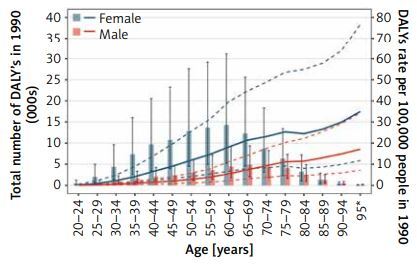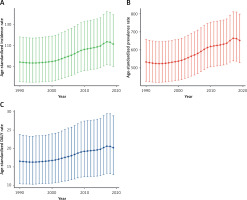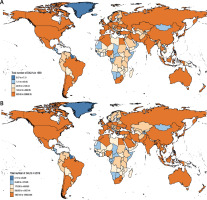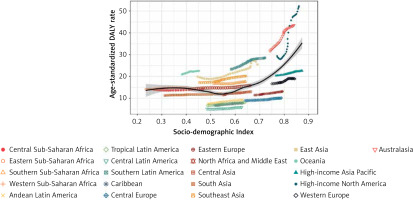Introduction
Gout is an inflammatory and metabolic disease characterized by arthritis and elevation of the serum uric acid (SUA) level [1]. It is one of the most common forms of inflammatory arthritis in adults and is 3–4 times more common than rheumatoid arthritis [2]. The uric acid crystallizes and deposits in the joints, tendons and surrounding tissues. It causes not only intense pain in the joints [3], but also a huge financial burden to patients. Poorly controlled gout will cause huge social costs, with direct costs estimated at $26,890 and indirect costs of $13,164.146 per year for patients with frequent seizures [4]. Currently, the prevalence of gout is increasing globally, with population-based studies from Asia, Europe, and North America reporting an incidence between 0.6 and 2.9 per 1,000 person-years, and an adult prevalence between 0.68% and 3.90% [5–8]. Part of the reason is due to aging of population, changes in diet and lifestyle factors, and an increase in the number of people with high body mass index (BMI) [9, 10]. Nowadays, the link between gout and high BMI is well established [11]. In a Mendelian randomized study, higher BMI was causally associated with gout and had no significant effect on other risk factors [12]. In another meta-study, the relative risk of gout increased by 55% for every five-unit increase in BMI [3]. Some studies have also suggested that high BMI may lead to an increase in SUA [13]. Lyngdoh et al. [14] also confirmed that there was a clear causal relationship between high BMI and SUA. Therefore, the increasing prevalence of high BMI is a fundamental factor contributing to the increasing trend of gout burden.
The Global Burden of Disease (GBD) study 2019 listed high BMI as a risk factor for gout. We use the latest data from GBD 2019 to describe and analyze the burden of gout caused by high BMI in 204 countries and regions from 1990 to 2019 in an epidemiological model, and we divide it by age, sex, country and region, and socio-demographic index (SDI). The aim is to better understand the impact of gout attributed to high BMI on population health and to provide insights for reducing the burden of gout disease.
Material and methods
Data source
The data of global burden of gout due to high BMI were obtained from GBD 2019. GBD is a comprehensive global assessment of the prevalence and impact of 329 diseases in 204 countries and territories, and divides 204 countries and territories into five groups based on the SDI: high SDI, high-moderate SDI, moderate SDI, low-moderate SDI, and low SDI. Disability-adjusted life-years (DALYs) and corresponding age-standardized rates (ASR) for gout patients globally attributable to high BMI from 1990 to 2019 were extracted and analyzed by age, sex, location, and year in this article.
Estimation of high BMI and attributable gout burden
In GBD 2019, high BMI refers to obese individuals with a BMI exceeding 25kg/m2. As no death toll caused by gout has been recorded in GBD, this study mainly investigated the incidence of gout and DALYs rate caused by high BMI. In the GBD study, the age-standardized DALYs rate of gout attributable to high BMI was calculated by applying demographic attribution analysis such as age, sex, location and year, and the disease burden was estimated by analyzing corresponding trends.
Statistical analysis
We analyzed all attributable gout burdens by age, sex, year, and location to determine the effect of high BMI on gout. When comparing different populations or the same population in different periods, we adopted DALYs’ ASRs to standardize the impacts caused by differences in the population structure. All reported cases and their ASRs per 100,000 people were within a 95% uncertainty interval (UI). R Development Core Team program (version 4.0.3) was used for all of the above analyses.
In this study we used Joinpoint to evaluate the temporal trend of DALYs rates. The rise and fall trend of DALYs rate can be expressed through the slope of the curve changing with time. Our study used Joinpoint software (version 4.7.0) for Joinpoint regression analysis. In addition, annual percentage changes (APCs) and their 95% confidence intervals were calculated, with significance level α = 0.05.
Results
Global burden of gout in the last 30 years
Globally, as shown in Supplementary Table SI, the prevalence of gout increased from 2.206 million cases (1.752 to 2.737) in 1990 to 5.387 million cases (6.634 to 4.338) in 2019, increase by 144.2%. As shown in Figure 1 A, age-standardized incidence rate of gout showed a noticeable increase from 1990 to 2019. In Figure 1 B and Supplementary Table SI, the age-standardized prevalence rate of gout was 533.0 (425.3 to 657.9) in 1990 and 652.2 (528.6 to 798.6) in 2019. In Figure 1 C, the age-standardized DALYs rate of gout increased from 16.55 (10.44 to 23.79) in 1990 to 20.23 (12.91 to 28.88) in 2019, showing an overall upward trend over the three decades, with the most significant increase from 2015 to 2017, and showing a downward trend after 2017.
The global burden of gout attributable to high BMI in 2019 and trends over the past 30 years
According to GBD 2019, as shown in Figures 2 A, B, the age-standardized DALYs rate of gout caused by high BMI has shown an increasing trend in the past 30 years, from 3.49 (1.49 to 6.69) in 1990 to 6.39 (3.15 to 11.39) in 2019 (Supplementary Table SII), with the most significant increase in 2002-2010 (APC = 3.38%, p < 0.05). In Figure 2 C, the rate of DALYs showed an increasing trend in male patients, with the largest increase in 2003-2010 (APC = 3.56%, p < 0.05). In Figure 2 D, the rate of DALYs in female patients also increased roughly, with the largest increase in 2006–2009 (APC = 3.6%, p < 0.05). Therefore, addressing the problems caused by a high BMI risk factor will be an important pillar of reducing the burden of gout [15].
Figure 2
Temporal trends of global gout burden attributable to high BMI from 1990 to 2019 in both genders. A – Total number of DALYs of gout and age-standardized DALYs rate per 100,000 people of gout. Age-standardized DALYs rate of gout attributable to high BMI in both sexes (B) in males (C) in females (D)
DALY – disability-adjusted life-year, BMI – body mass index.
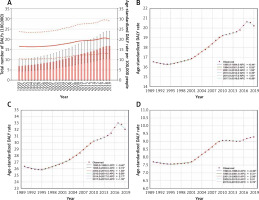
Age and gender specificity of gout attributed to high BMI worldwide
As shown in Figures 3 A and B, over the past 30 years, the age-standardized DALYs rate of gout due to high BMI increased dramatically in all age groups, with the largest increase in middle-aged and elderly people. The age-standardized DALYs rate of males was higher than that of females at all ages. The female group with the highest DALYs rate is older than that of males. In the gender subgroup analysis, Figures 3 C and D show that the age-standardized DALYs rate of gout due to high BMI increased in both sexes in the past thirty years among 21 regions worldwide and the increase was more prominent in males than in females. As shown in Supplementary Table SII, the age-standardized DALYs rate of gout due to high BMI increased from 5.45 (2.10 to 11.14) to 10.28 (4.77 to 18.96) in males and 1.72 (0.77 to 3.15) to 2.77 (1.37 to 4.78) in females over the past three decades.
Figure 3
Gout burden attributable to high BMI among different ages and sexes in 1990 and 2019. Total number of DALYs and DALYs rate per 100,000 of gout attributable to high BMI across all age groups in 1990 (A) and 2019 (B); Age-standardized DALYs rate of gout attributable to high BMI across 21 GBD regions among different genders in 1990 (C) and 2019 (D)
BMI – body mass index, DALYs – disability-adjusted life-years.
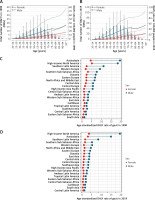
The global and regional burden of gout attributed to high BMI
The age-standardized DALYs rate of gout due to high BMI has increased in all regions of the world over the past 30 years. From a regional perspective, as shown in Figure 4 A, due to the increase in the population with high BMI in 2019, the age-standardized DALYs rate of gout in North America was the highest. At the same time, North America has also experienced the largest increase in age-standardized DALYs rate for gout since 1990. In contrast, the age-standardized DALYs rate of gout due to high BMI increased relatively slowly over the past 30 years in Europe and Africa. As shown in Figure 4 B, the region with the highest increase is Southeast Asia, in which the rate rose from 18 to 11 from 1990 to 2019. At the same time, in Central Sub-Saharan Africa, as the region with the highest decrease, the rate dropped from 12 to 19. At the region level shown in Figures 5 A and B, the highest DALYs of gout attributable to high BMI were 129,504.85 (increase from 69,710.71 to 211,499.85) in the United States and 115,104.21 (increase from 44,197.45 to 231,849.93) in China in 1990 compared to other countries, which remained the highest in 2019 (Supplementary Table SI). And the annualized rate of change in age-standardized DALYs rate for gout attributable to high BMI is 0.2 (0 to 0.4) and 1.2 (0.7 to 2.2), respectively, as shown in Supplementary Table SIII. In contrast, Greenland had the lowest DALYs due to high BMI in 2019 at 12.8 (6.4 to 22.7) (Supplementary Table SI). Besides that, the United States has the largest increase in DALYs associated with gout due to high BMI over the past 30 years.
Figure 4
Gout burden attributable to high BMI across 21 GBD regions in 1990 and 2019. Age-standardized DALYs rate per 100,000 people (A) and changes in age-standardized DALY rate (B) of gout attributable to high BMI in 1990 and 2019 across 21 GBD regions
BMI – body mass index, DALYs – disability-adjusted life-years.
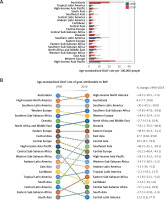
The relationship between the global burden of gout attributable to high BMI and SDI
The age-standardized DALY rate of gout due to high BMI varied greatly by SDI and generally increased with the rise of SDI. The results shown in Figure 6 indicate that areas with a heavy gout burden due to high BMI all have higher SDI. The gout caused by high BMI increased to varying degrees in almost all regions with different SDI, and the age-standardized DALYs rate of gout increased the most in regions with higher SDI, but areas with low SDI generally have a lower burden of gout with high BMI.
Discussion
Gout is the most common inflammatory arthritis worldwide [15]. The global epidemiological burden of gout has increased rapidly over the past 30 years. Risk factors such as high blood pressure, diuretics, genetic factors, excessive alcohol consumption, and high purine diets have been widely reported in the previous literature, which can increase the risk of gout [16–18]. However, high BMI is gradually becoming an important risk factor for gout disease, and its impact is more profound than some other behavioral risk factors such as smoking and alcohol consumption. The American College of Rheumatology guidelines recommend weight loss as part of gout treatment in obese patients [19]. On a global scale, overweight and obesity are on the rise, accounting for about 30% of the world’s population by 2022 [20]. Therefore, the effect of high BMI on the disease burden of gout needs attention and research urgently. In this study, we have analyzed the global burden of gout due to high BMI and its epidemiological changes over the past 30 years. To our knowledge, this study is the first to provide a comprehensive analysis of the spatiotemporal trends in gout caused by high BMI. Our results show that high BMI is a significant risk factor for gout in GBD 2019, and has been associated with SUA in most of the existing literature [21]. Our findings also support that high BMI greatly promotes the occurrence of gout disease.
In modern times, with the intensification of population aging, the burden of diseases is increasing [22, 23]. In our findings, gout with high BMI occurred more frequently in the middle-aged and elderly population. In some developed countries, the prevalence of gout in both genders aged 70–79 in 2012 was 11.8%, while the prevalence in both genders aged 50–59 was 5.1%, and the prevalence in both genders under 30 was only < 1% [6]. A study from Denmark showed that among gout patients between 1995 and 2015, the average age of onset was 65.3 years for males and 71.4 years for females [24]. Thus, the prevalence of gout increases with age, and this pattern of change is seen throughout the entire life cycle of both genders, but is particularly pronounced in women after menopause [15]. We believe that this is related to the increase in total body fat accumulation with age, which leads to the increase in the number of elderly individuals with high BMI. During the aging process, people tend to become more inactive, their energy consumption decreases, and this has an impact on energy metabolism [25], thereby increasing obesity. After fat accumulates in the body, it redistributes from the subcutaneous area to the abdomen, liver, muscles, and other ectopic parts [26], which leads to a generally high BMI index in the elderly population and exacerbates the burden of gout in this group. Studies by Tchkonia et al. [27] have shown that lifestyle changes in the elderly as they enter retirement may lead to a long-term positive energy balance, resulting in excessive accumulation of adipose tissue and accelerating the development of age-related diseases. Therefore, aging of the population also indirectly increases the age-standardized DALYs rate of gout caused by high BMI globally. We believe that the burden of gout attributed to high BMI in the elderly can be effectively reduced by paying attention to the BMI of the elderly, moderate exercise, and improving metabolism and energy expenditure.
In our gender subgroup study, our results show that the burden of gout caused by high BMI in males was higher than that in females, and this difference occurs in almost all age groups. We think these differences may be related to dietary habits and weight management of different genders. In daily life, men tend to consume more high-purine substances and have higher rates of smoking and drinking. Nevertheless, women pay more attention to body management and dietary intake, and the proportion of people with high BMI is lower. In addition, it has been reported that the increase of the SUA level in postmenopausal women may be caused by the decrease of the female hormone level, which also partly supports the higher prevalence of gout in elderly women [28, 29]. Therefore, the burden of gout caused by high BMI on both genders should receive better attention.
The burden of gout caused by high BMI varies significantly across regions and countries. As our results indicate, gout caused by high BMI is strongly associated with the level of social development of the country and region, which is consistent with some existing retrospective studies [30]. A published review study [30] showed that the prevalence of gout was the highest in Oceania and North America. This result also confirms our research findings that the high BMI population in the central part of North America is a major risk factor for the increased burden of gout in this region. The population structure, dietary structure, and lifestyle in North America are also related to the increase in high BMI populations and the sustained increase in the burden of gout. Southeast Asia and Central Sub-Saharan Africa are the regions with the biggest rise and decline recorded, respectively. We believe that this phenomenon is closely related to the increase in average life expectancy and changes in dietary structure of the people in these two regions over the past thirty years. In 2019, the United States ranked first globally in gout DALYs attributable to high BMI, while China ranked second, and the DALY’s ASRs for both countries have grown slowly over the past three decades. The relatively developed socio-economic level and dietary habits of excessive intake of fat and sugar in the local area have led to an increase in the population with high BMI, resulting in this outcome. On the contrary, regions such as Greenland have a relatively low level of development, simple and healthy dietary intake, and affected by population density, resulting in extremely low DALYs. We believe that such differences are closely related to regional socio-economic differences and the resulting differences in diet and lifestyle habits. In addition, the level of SDI was also positively correlated with DALYs of high BMI gout. Socioeconomic conditions play a crucial role in the increase of obesity [31]. With the increase of SDI, some developed countries have caused obvious changes in people’s diet structure, which leads to the increase in the number of people with high BMI and indirectly leads to the increase of gout burden with high BMI. Between 1980 and 2013, the global prevalence of overweight or obese (BMI ≥ 25 kg/m2) increased from 29% to 37% in males and from 30% to 38% in females [32]. This is strongly correlated with the general rise in SDI around the world. At the same time, as SDI increases, more and more gout prone foods become readily available, such as red meat, seafood and shellfish, fructose, sweetened soft drinks and alcoholic beverages, all of which increase the risk of gout [15]. This also indirectly increases the burden of gout caused by high BMI. A reasonable and effective weight management plan for the local population, improved dietary structure and moderate increase in physical exercise can effectively control the growth of high BMI individuals, thus reducing the burden of gout. In these areas where the burden of gout is increasing due to high BMI, healthy dietary habits and lifestyles should be promoted as soon as possible.
Previous studies have explored the global or country-specific epidemic trends of gout, but have not revealed the heavy burden of disease caused by high BMI as a risk factor, nor its temporal and global distribution. Our study provides insights for reducing the burden of gout and its corresponding controllable risk factors in different countries and localities, as well as providing assistance in reducing the economic burden caused by gout. Although we tried our best to enhance the authenticity and universality of this study, our analysis still has some shortcomings. First of all, the prevalence trend of gout varies greatly in different regions, and the data provided by some countries inevitably have some errors, which have a certain impact on the research results. Secondly, the effect of high BMI on human metabolism can indirectly damage the circulatory system and kidney function through some long-term complex mechanisms, which should not be ignored. The driving effect of one risk factor on other factors can lead to an overestimation of the burden on this risk factor. These factors all affect the comparability and extensiveness of this study.
In conclusion, this study has documented the increase in the global burden of gout due to high BMI from 1990 to 2019. The burden of gout caused by high BMI is greater in the elderly group, and countries and regions with high SDI, which poses a huge burden on human health and social economy. Our findings provide evidence for the burden of gout caused by high BMI, and identify the most severely affected population based on factors such as region and age group, which can help individuals with high BMI develop healthy weight management plans and lifestyle habits, so as to reduce the local disease and economic burden.


